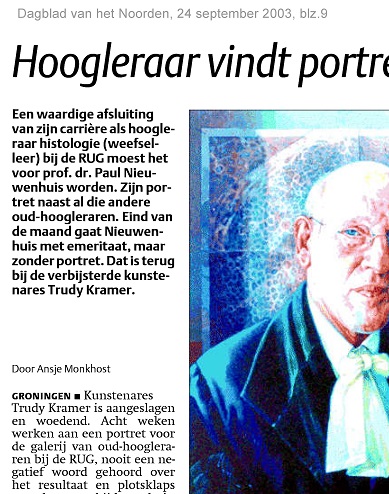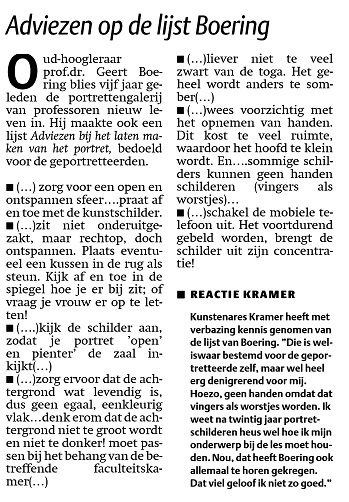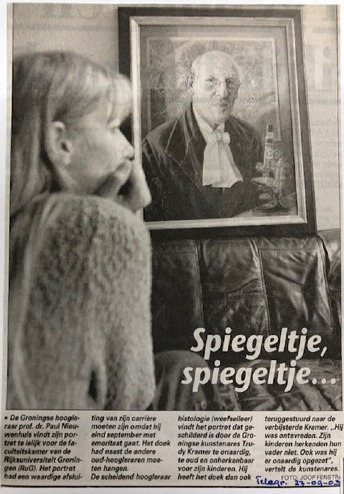Academic Portraits: the Boering Archive
In the Special Collections of the University of Groningen Library (UB), you can find the archive of Geert Boering, Professor of Oral and Maxillofacial Surgery. This archive has recently been made accessible. It comprises material about the position that Boering took on—together with the director of the University Museum—when he retired: continuing the UG tradition to honour certain professors with their own portrait. Under Boering’s auspices, a total of 166 portraits were made by 55 painters, among whom were famous artists, such as Sylvia Willink (portrait of Joosse), Matthijs Röling (portraits of Bakels and Lokin), and Sam Drukker (several portraits), between 2002 and 2015. Almost all faculties in the University of Groningen (UG) are represented.
Women form a small minority among those portrayed, because there are far less female than male professors. Not everyone wanted to have their portrait made, mind you. Sometimes, they did not want to spend the money—professors had to pay for their own portrait—and felt the faculty should pay for it. Others refused out of modesty or because they were unhappy with the UG. One professor refused because he found the presentation in the faculty room ‘a mess, ugliness squared’. Another refused because he could not handle it mentally and had the feeling that he would call down misfortune upon himself if he agreed to the portrait. Yet another professor was afraid that people would think him vain.
Professor Nieuwenhuis had his portrait taken by Trudy Kramer, an acquaintance. He withdrew the portrait, however, because he was displeased with the result. This created a huge commotion with detailed articles in the Dutch newspapers Dagblad van het Noorden and Telegraaf, and it was even discussed in an item in the Dutch satirical TV programme Kopspijkers.

Boering was not a big fan of computers, so his communication about the portraits consists of handwritten letters of sometimes no less than six pages. It is poignant to see his handwriting slowly deteriorating as he ages. The final letters, written just before he died, are almost impossible to decipher.
Not every professor who retired or passed away was eligible to have their portrait taken. The faculty dean had to declare whether someone had worked as a professor for at least ten years and whether they had made a valuable contribution. This second, subjective, criterium often gave rise to discussions, which in turn sometimes led to a fierce correspondence. Once permission was obtained, Boering approached the candidate and if they liked the sound of it, Boering would visit them with examples of artists’ work. Some candidates brought forward an artist themselves, but Boering wanted to at least have a say in it. For example, he was against choosing relatives or friends as the artist because, according to Boering, they rarely delivered a portrait of sufficient quality. To assess whether an artist was good enough, he sometimes first had his own portrait taken, which is why there are five portraits of him in existence.

He researched the artists, went to exhibitions, approached galleries and other art collections, and watched the Dutch TV programme Sterren op het Doek (Stars on the Canvas) without fail. He was also an avid collector of newspaper and magazine articles about Dutch portrait art. He asked artist friends to review their colleagues. He took a special interest in artists from the three northern provinces. Marcel Duran (eleven portraits) provides a glimpse of Boering’s work method. He regularly visited the artist to check on the painting’s progress and had photos sent to him of the process that he commented on. The portraits had to be well-proportioned and naturalistic with the professor wearing a gown, and without the ‘small head syndrome’ because ‘then you would be buying an awful lot of air and textile’, according to Boering. Since the portraits were all hung together, they had to convey a certain unity as well. If Boering was aware of an aversion between two candidates, he would make sure their portraits were hung at a considerable distance from each other.
Every year, he organized a festive gathering with the candidates, their friends and relatives, and the artists concerned attending, where that year’s ‘portrait harvest’ was officially presented. The gathering included a lecture and a fancy dinner.
The magazine Broerstraat 5 frequently wrote about the portrait collection. If the article was not to Boering’s liking, the editor could expect a letter. Likewise, if the collection did not receive enough attention in his opinion, he would also take up his pen.
Boering was personally involved in the entire process. If something tragic happened, he would send a letter. When a professor passed away, his widow received a letter of condolence. Subsequently, Boering would tactically move on to ask whether she might like to have a portrait made of her late husband. He developed a special relationship with many artists. The opening of his letters changed from ‘Dear Madam ...’ to ‘My dear ...’. The correspondence would from then on not only focus on work but also on how his hydrangeas were holding up and what was on the menu for his Christmas dinner. He was also involved with the artists on a professional level and would, for example, encourage someone to use more colour or to have a website made.

The archive also offers a glimpse into Boering’s personal life, in particular his hobbies. He had a whole range of hobbies, most notably his place of residence and his hydrangeas. As a born and bred ‘Drent’—a person from the Dutch province of Drenthe—Boering settled in the Groningen village of Noorddijk. He was a great advocate for the village and was therefore dubbed ‘the mayor of Noorddijk’. He held lectures about the history of the village and arranged that one of its residents was given a decoration. Boering himself was appointed Knight in the Order of the Dutch Lion.
His other favourite pastime was collecting and cultivating hydrangeas. His garden was full to the brim with them. To illustrate, he collaborated on the book Encyclopedia of Hydrangeas and local TV channel TV Noord’s weatherman once even did a broadcast from Boering’s garden.
The archive presents Geert Boering as a clearly capable as well as amiable and committed human being. Someone who felt compassion for the people around him, as evidenced by the numerous personal letters the archive holds. Many Groningen artists will be grateful to him for promoting their work and raising their profile. Through this project, Boering has contributed significantly to the UG’s portrait collection, and Groningen painting came into the limelight.

